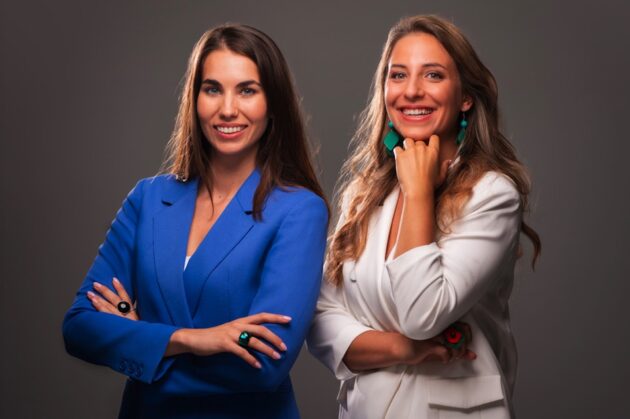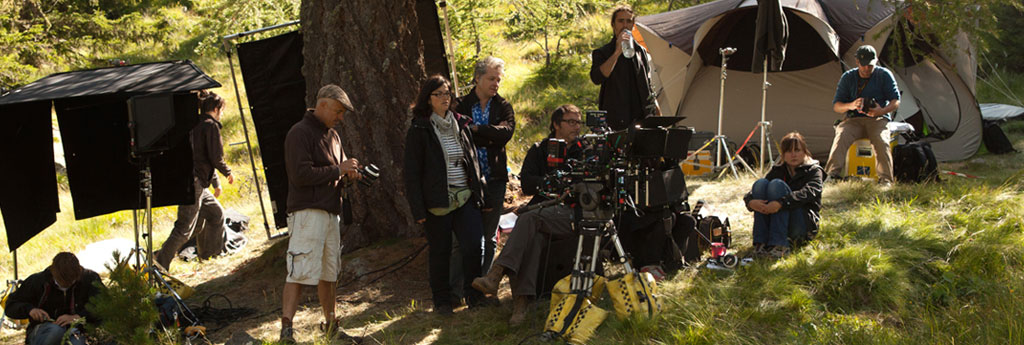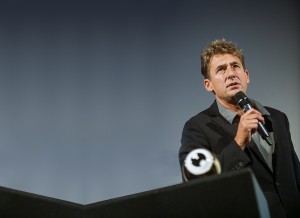
With Green Eyes Productions Júlia Tordai and Zsófia Szemerédy provide sustainbility consultancy for the film, TV and entertainment sector since 2021. The projects they were involved as sustainability consultants include Moon Knight, the award-winning feature film Poor Things, Hijack, Dune: Prophecy, and Alien: Romulus. Currently, the Green Eyes founders are actively engaged in sustainability consulting on multiple productions.
What is the approach you are taking?
Zsófia Szemerédy: At Green Eyes Productions, our approach is defined by a holistic view and a profound respect for creativity and artists. We love and respect the industry, and it is paramount to us to acknowledge that we are here to aid filmmakers on their journey of creating a dream, all the while ensuring it is done as sustainably as possible. Our strength lies in bridging the gap between creativity and science. While we do not claim to be experts in every subject, we make it a point to call in the right people—the actual experts—and translate their knowledge to best fit the unique needs of the film industry.
Júlia Tordai : We tailor effective plans for each project to try to achieve carbon neutrality without sacrificing practicality or the essence of the project. We ensure sustainability is a core consideration from day one, focusing on eco-friendly locations, supply chain, and budget. Our comprehensive sustainability plan is tailored to each production, and we emphasise clear communication and collaboration across all departments. This proactive approach integrates sustainability into every aspect of the production, balancing creative vision with environmental responsibility.
At what time do you get involved in a production?
ZS: Every project is different. Every year is different. We are being called in earlier and earlier, and ideally, we will be consulted at the greenlight stage in the future, as sustainability has a significant impact on the production budget. I am delighted to say that the earliest I have recently been called in was just after greenlight, allowing us to train key decision-makers and review scripts at an early stage. This is an extremely significant step for the entire industry. When we are called in at week -8 or later, our impact is limited. As a perfectionist, I hope we continue to be involved earlier and earlier. This is why I am deeply invested in how policies, mandates, and incentives can be real game changers for the wider industry through a top-down approach.
JT: We get involved as early as possible, ideally at the greenlight stage, even before pre-production begins. This early involvement allows us to implement the best sustainability plan, guiding sustainable decision-making from the start. Furthermore, it gives us an opportunity s to analyse and provide feedback on the script, implementing best practices for sustainability wherever possible, without compromising the integrity of the storytelling.
What are the biggest challenges in greening the productions?
ZS: Money, time, bureaucracy, dinosaurs.

JT: One of the biggest challenges in greening productions is that filmmakers are often deeply focused on the creative process, and other considerations, like sustainability, tend to take a backseat. Unlike health and safety, which have clear regulations and financial repercussions, sustainability lacks comprehensive standards. This lack of mandatory guidelines make our job more difficult, as we have to proactively find allies who prioritise green practices. Additionally, the high-pressure environment of film production means that sustainability initiatives are often the first to be set aside when time and resources are limited.
With new demands are coming new opportunities. How does the increasing awareness for eco-friendly production approaches translate into action?
ZS: We are being asked to get involved earlier and earlier, which I believe is a significant development. Moreover, we are approached by various stakeholders—not just film productions, but also institutions, universities, film funds, festivals, agencies, and more. I can see a true grassroots movement rising, with a lot having changed in the past five years in that regard. Even more change is on the horizon with the forthcoming widespread enforcement of ESG regulations. Ever the optimist, I see these regulations as an opportunity. I also hope that incentives will play a pivotal role in this transition. It has already begun, as evidenced by the 5% bonus in Austria, and now we need to see an escalation of such measures across the globe.
In which departments or sectors do you see the biggest eco-conscious improvements?
ZS: So, funnily enough, every department has its own mantle. I don’t think I can look at it department by department. Change comes from leadership; if the Make-Up HoD, the Costume HoD, or the Locations Manager each have the drive, they will make significant changes within their remit. We all have our individual leverage points. The key here is unlocking finances, support, and additional time. This comes from the respective financiers and producers. Until we live in a world where having a healthy sustainability line in a production budget is not compulsory for every production, we are just fighting an uphill battle. Let’s hope the 1% rule applies: 1% of the entire industry is enough to move the needle and shift the way we operate.
JT: The biggest chunk of the carbon footprint in film production usually comes from energy use. So, if we want to reduce our CO2e emissions and have the biggest impact, we need to focus on that. I see that key departments like location, transportation, and the electrical department are making strides. Traditionally, these departments have relied on diesel generators, but now more renewable or hybrid solutions are becoming available on the market. Other departments also have eco-conscious technologies and options they can implement. As Zsófia mentioned, the adoption of these sustainable practices often depends on leadership support and commitment.
What kind of impact has technology?
ZS: Just like with most things, it has to be understood how best to use it. It can have fantastic advantages. But, I’d also be vary that sometimes a common sense approach can be as impactful as a new technology.
JT: Technology has a profound impact on greening film and TV productions by enabling more sustainable practices and reducing the industry’s environmental footprint. Advanced technologies, such as LED lighting and energy-efficient cameras, significantly cut energy consumption on set, while virtual production and CGI reduce the need for physical sets and travel in certain instances. Embracing digital workflows decreases reliance on paper and physical resources, and sustainable set design using 3D printing minimises waste. Data analytics tools help monitor and manage carbon footprints in real-time, allowing for informed decision-making. Remote collaboration tools reduce the need for travel, saving time and lowering carbon emissions. Additionally, the use of renewable energy sources, such as portable solar panels, provides clean energy alternatives. By leveraging these technological advancements, the film and TV industry can significantly enhance its sustainability and reduce its environmental impact.
What are the drivers of green production?
ZS: In my views it’s a combination of a very charismatic, and driven handful of individuals as well as external pressure from governments, society, audiences and businesses.
JT: The drivers of green production come from various sources. There are industry leaders and influential filmmakers who are passionate about sustainability and use their platform to advocate for greener practices. Their commitment often sets a standard for others to follow. Regulatory bodies and government incentives play a crucial role by establishing guidelines and providing financial incentives for sustainable practices. This helps push the industry towards greener solutions. We can’t forget about the growing awareness and demand from audiences for environmentally responsible productions. As consumers become more eco-conscious, they expect the same from the content they consume. There are more and more sustainability film professionals who are vital in driving green production. They bring expertise and knowledge to implement and maintain sustainable practices on set. All these drivers collectively contribute to the shift towards more sustainable film production practices.
What is the most ambitious project you have been working on? Can you give an insight into it?
 ZS: There are a few, and they are all connected. Some of the productions we are working on are aiming to be diesel-free. This goes to the extent that we look at what fuel goes into the tower lights, for example, and we switch it to electric or HVO. We also examine the vehicles driven by the production team, including unit cars, and replace them with electric or HVO alternatives. We provide HVO on-site and urge all involved suppliers to expedite their transition. This is a very tangible goal.
ZS: There are a few, and they are all connected. Some of the productions we are working on are aiming to be diesel-free. This goes to the extent that we look at what fuel goes into the tower lights, for example, and we switch it to electric or HVO. We also examine the vehicles driven by the production team, including unit cars, and replace them with electric or HVO alternatives. We provide HVO on-site and urge all involved suppliers to expedite their transition. This is a very tangible goal.
Personally, I consider green storytelling, budgeting, and financial incentives to be my most ambitious projects. I believe the entire landscape can be changed if we bring sustainability into the conversation early enough. What’s earlier than finance and scripts? Planning and understanding are key to everything. Finally, messaging is gold. Film and TV have been used for propaganda in the past; it’s no secret. Whether for good or bad, the innate power they possess by reaching large audiences is undeniable. It’s difficult to measure this kind of impact, but one can only hope it’s there when it comes to green storytelling and how it’s depicted on screen!
JT: Each project presents its own unique challenges, as film productions vary greatly with different crews, scripts, and locations. This variety is one of the reasons I love this work; you can never get bored. I thrive on growing from project to project, continually learning and setting new ambitions with each one. One particularly ambitious project we worked on involved a crew and producer who were initially resistant to sustainable practices. The location also posed significant challenges as it relied heavily on diesel generators. Despite these hurdles, we were able to implement several green initiatives, including the use of hybrid generators, battery packs, HVO and waste reduction strategies. This experience was incredibly rewarding, as it not only tested our skills but also reinforced the importance and feasibility of sustainable production practices.
You are providing green training at the Screen Institute. What do you cover in the curriculum?
ZS: All of the above. As a perfectionist, I’m grappling with how not to overload the curriculum. But we can promise you that it will be an all-encompassing week. My goal is to help you find your leverage point, no matter which segment of the film industry you are coming from. My aim is to equip you with enough knowledge and drive that you feel empowered to make a significant impact in your life once you return home, without hesitation. Moreover, we want you to be able to empower your peers to do the same, thereby creating a domino effect. You will cover sciences, communication, green storytelling, carbon footprints, energy, finance, incentives—basically, all the fun stuff!













 Robert Redford
Robert Redford Hannes Jaenicke
Hannes Jaenicke Nic Balthazar
Nic Balthazar Nadeshda Brennicke, Actress
Nadeshda Brennicke, Actress Darren Aronofsky, Director, Noah / Jury President, 65th Berlin International Film Festival
Darren Aronofsky, Director, Noah / Jury President, 65th Berlin International Film Festival Tim Bevan
Tim Bevan Thekla Reuten
Thekla Reuten Rachael Joy
Rachael Joy Nikola Rakocevi
Nikola Rakocevi Nadja Schildknecht
Nadja Schildknecht Michael Bully Herbig
Michael Bully Herbig Lars Jessen
Lars Jessen Helen Hunt
Helen Hunt Douglas Trumbull
Douglas Trumbull Dieter Kosslick, Director Berlin International Film Festival
Dieter Kosslick, Director Berlin International Film Festival Benoit Delhomme
Benoit Delhomme Jeremy Irons
Jeremy Irons